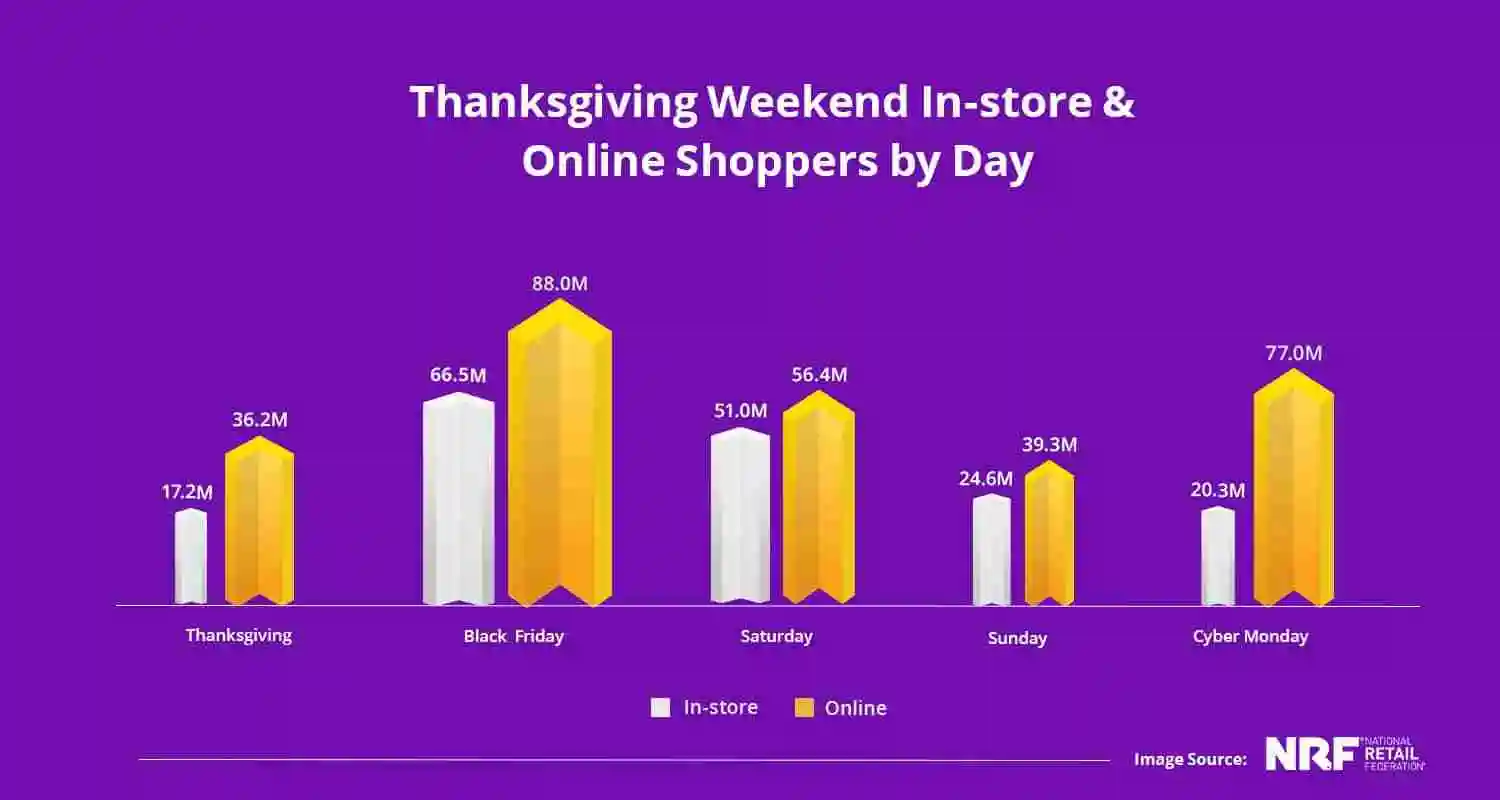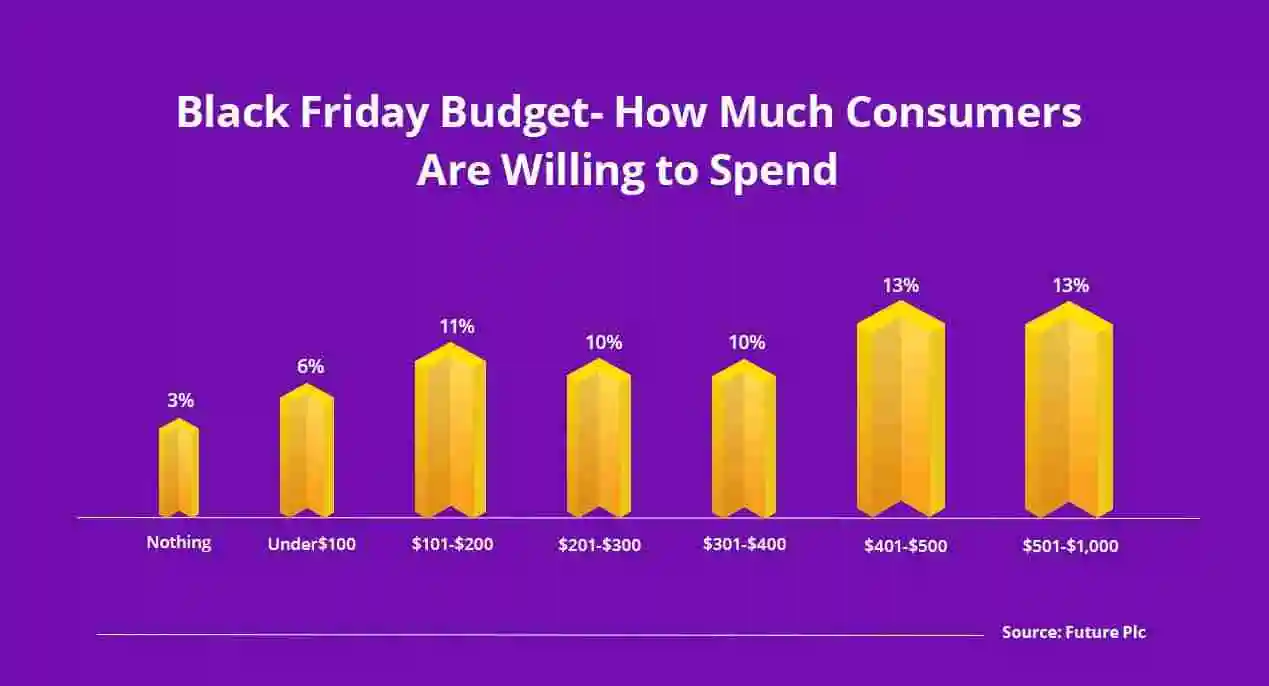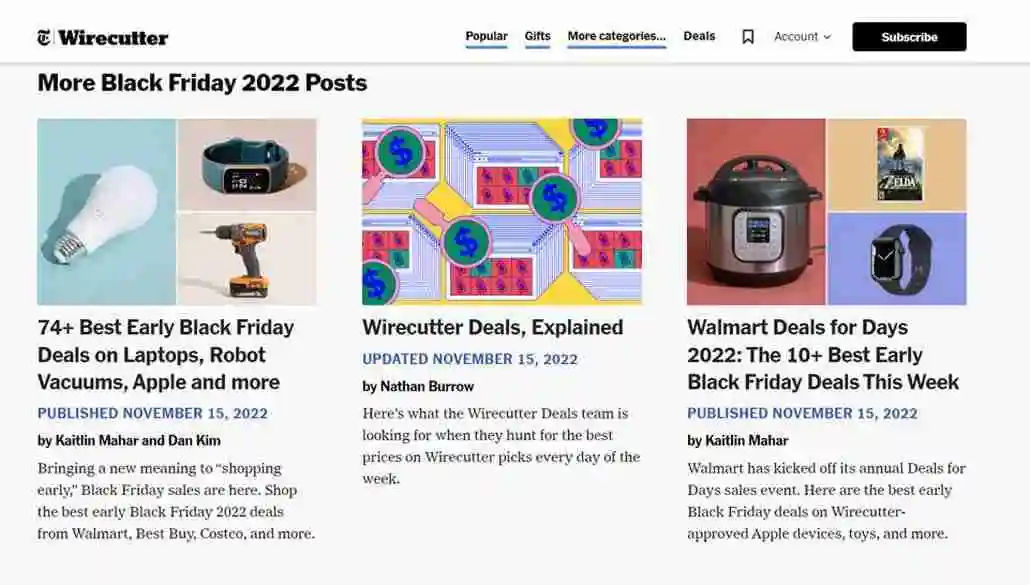Black Friday is unquestionably one of the most significant shopping events of the year and is the one that heralds the Christmas shopping season. As consumers swarm online and retail stores on Black Friday to grab the best holiday deals, advertisers try to bring their A-game with ad creatives and budgets to attract the maximum number of customers.
According to a study by National Retail Federation, 88 million Americans shopped online last year on Black Friday, surpassing Cyber Monday and Thanksgiving sales.
“Over the last few years, Black Friday has emerged as a powerhouse day for both in-store and online shopping.”
– Phil Rist, EVP, Prosper Insights and Analytics (Src)

Image Source: National Retail Federation
However, with the onset of a possible recession, consumers might want to spend their holiday budgets a lot more strategically this year. Therefore, as advertisers look to maximize their sales through enticing ad campaigns, publishers must ensure that their websites can offer high exposure to relevant audiences for maximum conversions.
Let’s explore what Black Friday 2023 has in store for publishers and how they can tap into the potential of the biggest shopping season for a profitable quarter.
Table of Contents
Black Friday 2023 Forecast
The festive season always brings happiness and love, and people love to celebrate it with great enthusiasm. The spending on food, travel and gifts generally increases, especially during Black Friday, which brings in post-thanksgiving sales at highly discounted rates. Trends will remain the same during this year despite the rising inflation.
Future plc, a leading enterprise publisher from the U.K., published the Rising Inflation Insights Report. The report explores the impacts of inflation and economic challenges on retailers and advertisers and provides Black Friday and holiday shopping insights for 2023. It also shows where consumers will spend time looking for the best deals. We also have included insights from the Holiday Spending Forecast 2023, published by Commerce Signals; a consumer spends insights provider.
Based on their survey and consumer spending data, these reports analyze consumer trends during the holiday season.
- Future plc report predicts good growth opportunities for the publishers and advertisers, with 94% of consumers affirming that they will turn to online content to balance their spending amidst rising costs. They would prefer to navigate across channels to find out the best deals and expert reviews.

Image Source: Future Plc
- Commerce Signals’ data forecast that Black Friday week sales will increase by 16% this year compared to 2022. As per Future plc, 80% of the audiences are looking forward to Black Friday and Cyber Monday shopping deals.
- As the effects of the pandemic wane, footfall in retail shops is likely to increase. However, customers will still prefer to shop online during Cyber Monday. Thus, there will be a very slight difference between online (12%) and retail sales (10%).
- The travel sector is also predicted to grow by 32% compared to last year. This year air travel spending takes the top spot, followed by hotels and other transportation modes. A similar effect will also take over the restaurant industry as spending is projected to increase by 25%.
- With highly promoted sales across all brands, Black Friday 2023 consumer spending is predicted to reach $158 billion. And around 13% of U.S. citizens are willing to spend around $400 to $1000 on Black Friday shopping.

Image Source: Future Plc
5 Strategies to Maximize Revenue During Black Friday
With a high influx of shoppers, brands are looking for ways to reach out to as many potential customers as possible. This brings a golden opportunity for the publishers to fill their ad inventories amidst the high demand.
We have curated a few essential holiday strategies to help publishers maximize their revenue during Black Friday weekend shopping.
Organize The Holiday Content Calendar
Organizing the holiday content calendar can be stressful for publishers as they must juggle website performance, ad optimization, and content development. While all three of these play a crucial role for a publisher, there’s one out of these which can be planned to reduce some of the last-minute stress. By planning and organizing the content calendar well in advance for Black Friday, publishers can have content ready to go live as the day comes close.
By identifying past content that worked for the readers and analyzing its performance, publishers can find more granular topics for content development that can fill the gaps. Since content plays a crucial role in attracting relevant audiences during Black Friday and all holidays, for that matter, by understanding readers’ content consumption and shopping habits, publishers can maximize the chances of delivering higher impressions to advertisers.
Wirecutter, a product review publisher, acquired by The New York Times, has a dedicated content team to work on Black Friday content. The publisher shortlists important Black Friday deals from tens of thousands of deals for their readers, starts publishing content after mid-November, and keeps readers notified of the hose of deals. The publisher also runs a newsletter to keep the readers posted about the latest Black Friday deals.

Image Source: Wirecutter
Similarly, CNN produces eCommerce content during Black Friday under CNN underscored. The publisher’s content team performs an extensive online search to find the best Black Friday deals.

Image Source: CNN underscored
Black Friday is just the beginning of the holiday shopping that will continue until Christmas. So, publishing content throughout Black Friday week can help publishers and advertisers get better and longer exposure. Publishers can use tools like Google Trends and YouTube trends to discover trending search topics on the internet.
Improve Targeting Strategy
Being in the last quarter of the year, advertisers will go all out to boost their sales exposure by trying to reach as many consumers as possible. Publishers who can offer relevant audience segments to advertisers with their inventory will attract higher CPMS. But without a suitable audience targeting framework, offering good ad exposure in terms of viewability, impressions and clicks is a challenge for publishers.
Regardless of the industry-wide dilemma over third-party cookie tracking and ID solutions, it is safe to assume that a targeting strategy based on first-party data can be helpful for both publishers and advertisers during the holiday season. Incorporating a mix of both behavioral and contextual advertising based on first-party data can help publishers capture the attention of different audience segments.
Publishers can also improve their contextual targeting capability by adding key values in Google Ad Manager. Key values are additional parameters that can be added to an ad request to refine the targeting criteria. It allows publishers to add certain ‘key-value’ to their inventory, such as content categories, sub-categories, or age ranges so that advertisers who want to reach consumers within a specific bracket can easily target them. Publishers can also make informed decisions and help advertisers by tracking user activities and conversions in Google Ad Manager.
Curate High-performing Inventory Packages
Brands are on top of their game during holiday campaign executions, and therefore advertisers look for the best platforms to showcase their brand for maximum engagement and conversions. This opens up an opportunity for publishers to present their most rewarding and high-performing inventory to advertisers and get better CPMs.
Though private auctions are a good platform for advertisers to get their message delivered to ideal audiences, it is direct deals that take the top spot when it comes to higher CTR and conversion rates.
By bundling their high-performing inventories in packages, publishers can be in a better position to negotiate their offerings directly with advertisers for maximum returns during the holiday season.
Focus on UX and Website Performance
Shoppers have a lot of options to choose from when it comes to holiday shopping, especially during cyber week. For a publisher, there is no scope for latency and delays while serving ads. With each second of delay, publishers can lose up to 2% of their total impressions. The actual loss in impressions will naturally be much higher during holidays.
Offering a pleasant experience through content and UX design on a website is the easiest way to ensure higher engagement. With consumer expectations at their highest, advertisers won’t go for publishers with poor page experience and website performance. Finding the right balance between ads and user experience is key during holiday campaigns. By understanding consumer behavior, publishers can optimize their websites to improve ad performance.
Track, Monitor, and Optimize Campaigns Regularly
Good times go by in a flash! And with the hustle of the holidays, things can spiral out of control very quickly. That’s why publishers must track and monitor how different campaigns on their websites are performing. Advertisers will take notice if the ads are not performing as they are supposed to, which can lead to low CPMs over time.
With traffic and consumer shopping hitting a peak during the holiday season, publishers need to ensure that they have the right ad setup and apt ad ops support to take care of all the issues related to ad management and delivery at the eleventh hour. Publishers often outsource their ad operations depending on their scale and traffic.
By having a reliable ad ops team, publishers can ensure the campaigns on their website are monitored constantly, and any required changes are implemented fluently. Optimizing ad campaigns, let’s say, by changing ad placements or targeting attributes can significantly impact performance and ad revenue.
Therefore, constant monitoring and early actions can be the defining factor for the success of an ad campaign. Optimizing campaigns in real-time can help maximize impressions for publishers to make the best of the consumer holiday spirits.
What’s Next?
With Thanksgiving just around the corner, it is high time for publishers to tighten their belts and strap in for the holiday shopping extravaganza. Even with the luring recession, consumers’ shopping spirits are peaking. Advertising is an important means of delivering advertisers’ messages to their ideal customers. And publishers play an important role here. With so many brands vying for consumers’ attention, developing a smart strategy is necessary. Publishers can opt for different strategies, including experimenting with the best ad sizes, starting with advanced monetization techniques like header bidding, or leveraging the benefit of website optimizationto have a competitive advantage.























